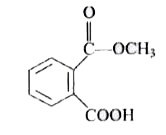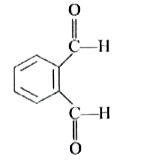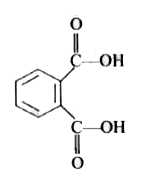Which of the following on reaction with conc. NaOH gives an alcohol ?
Methanal
Ethanal
Propanal
Butanal
The correct Answer is:A
To solve the question of which compound reacts with concentrated NaOH to give an alcohol, we need to understand the Canizzaro reaction. This reaction occurs with aldehydes that do not have alpha-hydrogens. Let's break down the solution step by step.
1. Identify the Reaction Type:
The question involves the Canizzaro reaction, which is a redox reaction that occurs with aldehydes lacking alpha-hydrogens.
2. Understand the Requirement for Canizzaro Reaction:
For a compound to undergo the Canizzaro reaction, it must not have any alpha-hydrogens. This means that the carbon atom adjacent to the carbonyl group (C=O) should not have any hydrogen atoms attached.
3. Analyze the Given Options:
We need to examine the provided compounds (not listed in the question but assumed to be common aldehydes) to identify which one lacks alpha-hydrogens. Common candidates include:
- Formaldehyde (HCHO)
- Benzaldehyde (C6H5CHO)
- Ethanal (CH3CHO)
- Propanal (CH3CH2CHO)
- Butanal (CH3CH2CH2CHO)
4. Identify Compounds with No Alpha-Hydrogens:
- Formaldehyde (HCHO): No alpha-carbon, hence no alpha-hydrogens.
- Benzaldehyde (C6H5CHO): No alpha-carbon, hence no alpha-hydrogens.
- Ethanal (CH3CHO): Has an alpha-carbon (CH3), hence has alpha-hydrogens.
- Propanal (CH3CH2CHO): Has an alpha-carbon (CH3CH2), hence has alpha-hydrogens.
- Butanal (CH3CH2CH2CHO): Has an alpha-carbon (CH3CH2CH2), hence has alpha-hydrogens.
5. Conclusion:
The compounds that can undergo the Canizzaro reaction and yield an alcohol are Formaldehyde and Benzaldehyde. However, since the question asks for a single answer, we can conclude that Formaldehyde (option A) is the primary compound that reacts with concentrated NaOH to give an alcohol (methanol).
Final Answer:
Formaldehyde (HCHO) is the compound that reacts with concentrated NaOH to give an alcohol.
The question involves the Canizzaro reaction, which is a redox reaction that occurs with aldehydes lacking alpha-hydrogens.
For a compound to undergo the Canizzaro reaction, it must not have any alpha-hydrogens. This means that the carbon atom adjacent to the carbonyl group (C=O) should not have any hydrogen atoms attached.
We need to examine the provided compounds (not listed in the question but assumed to be common aldehydes) to identify which one lacks alpha-hydrogens. Common candidates include:
- Formaldehyde (HCHO)
- Benzaldehyde (C6H5CHO)
- Ethanal (CH3CHO)
- Propanal (CH3CH2CHO)
- Butanal (CH3CH2CH2CHO)
- Formaldehyde (HCHO): No alpha-carbon, hence no alpha-hydrogens.
- Benzaldehyde (C6H5CHO): No alpha-carbon, hence no alpha-hydrogens.
- Ethanal (CH3CHO): Has an alpha-carbon (CH3), hence has alpha-hydrogens.
- Propanal (CH3CH2CHO): Has an alpha-carbon (CH3CH2), hence has alpha-hydrogens.
- Butanal (CH3CH2CH2CHO): Has an alpha-carbon (CH3CH2CH2), hence has alpha-hydrogens.
The compounds that can undergo the Canizzaro reaction and yield an alcohol are Formaldehyde and Benzaldehyde. However, since the question asks for a single answer, we can conclude that Formaldehyde (option A) is the primary compound that reacts with concentrated NaOH to give an alcohol (methanol).
Formaldehyde (HCHO) is the compound that reacts with concentrated NaOH to give an alcohol.
Topper's Solved these Questions
- ALDEHYDES,KETONES & CARBOXYLIC ACIDS BOOK - VMC MODULES ENGLISHCHAPTER - ALDEHYDES,KETONES & CARBOXYLIC ACIDS EXERCISE - IN-CHAPTER EXERCISE-I
10 Videos
- ALDEHYDES,KETONES & CARBOXYLIC ACIDS BOOK - VMC MODULES ENGLISHCHAPTER - ALDEHYDES,KETONES & CARBOXYLIC ACIDS EXERCISE - IN-CHAPTER EXERCISE-j
10 Videos
- ALDEHYDES,KETONES & CARBOXYLIC ACIDS BOOK - VMC MODULES ENGLISHCHAPTER - ALDEHYDES,KETONES & CARBOXYLIC ACIDS EXERCISE - IN-CHAPTER EXERCISE-G
10 Videos
- ALCOHOLS, PHENOLS & ETHERSBOOK - VMC MODULES ENGLISHCHAPTER - ALCOHOLS, PHENOLS & ETHERSEXERCISE - Impeccable
100 Videos
- AMINESBOOK - VMC MODULES ENGLISHCHAPTER - AMINESEXERCISE - IN CHAPTER EXERCISE H
10 Videos
Similar Questions
Knowledge Check
Which of the following reactants on reaction with conc. NaOH followed by acidification gives the following lactone as the only product?
 A
A B
B C
C D
D
Which of the following reactions will give 2∘ chiral alcohol as major product?
A BCH3MgI(excess)+H−O∣∣C−O−CH2CH3H3⊕O−−→C
BCH3MgI(excess)+H−O∣∣C−O−CH2CH3H3⊕O−−→C DPhMgBr+CH3−O∣∣C−PhH3⊕O−−→
DPhMgBr+CH3−O∣∣C−PhH3⊕O−−→Which of the following compounds on reaction with excess CH3MgBr and subsequent hydrolysis will give a tertiary alcohol?
AC2H5CHOBC2H5CO2CH3CC2H5COOHD
Which of the following reactants on reaction with conc. NaOH followed by acidification gives following lactone as the main product ?

View SolutionWhich of the following do not give aldol reaction with dil. NaOH
View SolutionWhich of the following on reduction with LiAlH4 will give ethyl
alcohol ?
View SolutionWhich of the following reactions will not yield alcohol as the major product ?
View Solutionwhich of the following compounds on reaction with NaOH and
H2O2 gives yellow colour ?
View Solution

